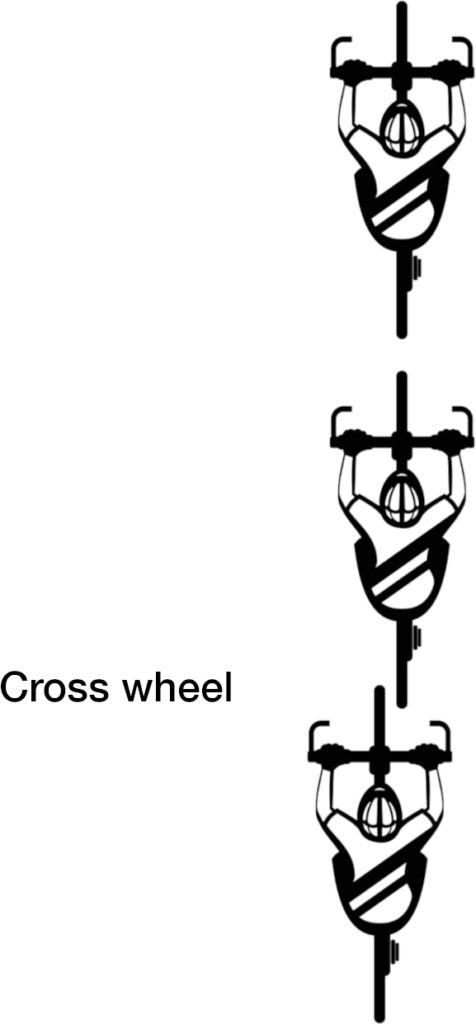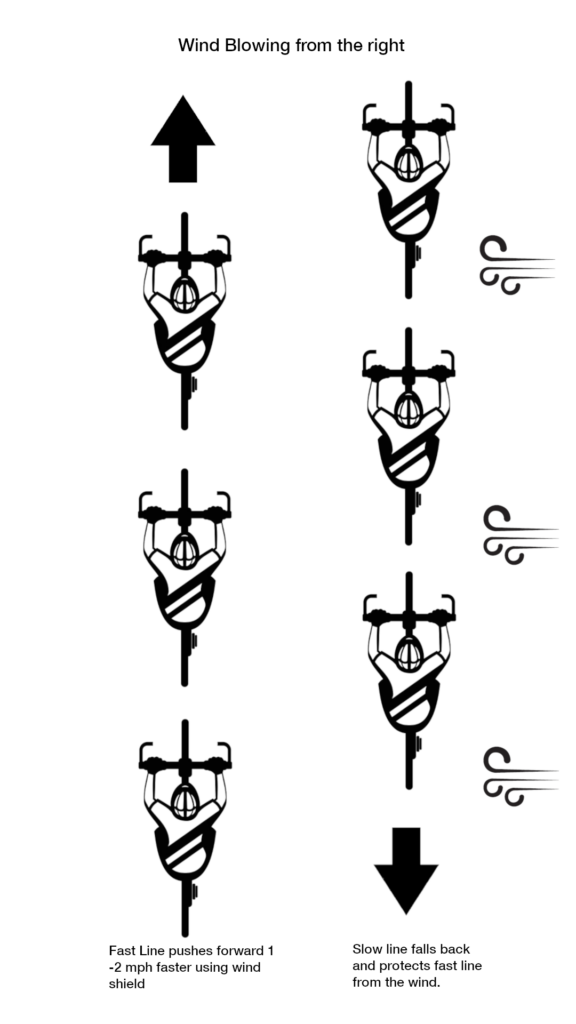Group Ride Etiquette
- If a ride leader or sweep asks you to take a certain action, (move over, single up, stay out of a lane, so on) please know they are doing so for the safety of everyone out on the ride. Please take the requested action.
- Pass back any hand signals and vocal calls from the lead to ensure everyone in the group is aware of what’s coming up.
- A rider in front of you has the right of way. If passing another rider, it’s your responsibility to ensure you have enough room to pass and maneuver around the rider safely. Best to vocalize your intent so they know you’re coming.
- Don’t pass between two riders riding side by side if it can be avoided. Wait for a safe spot to pass.
- Try to indicate your intent to move/shift lane position to other riders behind you. If shifting to a gap on your left, point to the left gap you intend to fill. That way if someone behind you, that you are unaware of, is attempting to pass, they can react. You have right of way, but it’s better to let everyone know your intent.
- Cars will always win. They’re big and made of metal. We’re made of flesh and bone.
- There’s what’s legal and what’s safe and smart. We want to promote good relationships between cyclists and motorists. Just because it’s your right to consume the entire lane, doesn’t mean you should. Understand that we have to share the road and that roads in KC were designed for motorists more than cyclists. This design paradigm leads to feelings of entitlement among motorists, and can generate anger/hatred when they can’t use the roads the way they feel they were designed to be driven. Both sides must make concessions, but when in doubt, refer to “Cars will always win.”
- Move over to the right and make room when you hear “<Thing> Back.” Riders behind have recognized a car/vehicle trying to pass. Refer to “Cars will always win.”
- Pace lines are fun, but also carry risks due to the speed and proximity to other riders, do not join in on a pace line unless you understand your role once you join and are comfortable with the pace and proximity to other riders.
- Be awesome!
Pace Line etiquette
- Do your fair share! Pull when it’s your turn
- If out riding solo, and you see a pace line, ask before hopping on. Understand that it’s okay for them to say, “no” They may be practicing for an event or wanting to keep the line just to their group/club.
- When pulling in a pace line, do not surge. Keep the pace constant so that everyone can stay together.
- If pulling on a Single or double line, It’s your job to indicate when you’re done. Don’t wait for someone to overtake you. Pull as long as you’d like. Just, be sure to leave enough energy to be able to hop back on to the line as you rotate back.
- If you need to step out. Vocalize your intent, use the elbow flip, and fall out away from the other riders and traffic as safely as possible.
- Do not cross wheels: The rider in front of you may need to maneuver quickly to avoid road hazards you’re not aware of. Cross wheeling could cause them to clip your front wheel as they maneuver and cause an accident.
- Maintain 3-4 feet of separation between you and the rider in front of you.
- If you’re having trouble maintaining the pace, vocalize and ask the group to slow down a bit.

Pace Line Types
Single Line
Best for groups of 4 or less. Form a single file line behind the rider pulling. When the puller is done, they will elbow flick to indicate they’re done and which direction they intend to rotate out. The puller moves out to the safest side, and eases off the power to rotate to the back and rejoin the line.
Double Line
Best for groups of 5 or more when there is a disparity of skill level within the group. It behaves as two single lines next to each other. Right and Left. Pullers pull as long as they’re capable. When rotating out, always rotate to the outside of the pace lines, not between.
Rotating
Best for groups of 5 or more riders of similar skill level. There are two lines of riders. A slow line and a fast line. The slow line is moving forward but recovering at a slower pace. The fast line moves forward 1-2 mph faster than the slow line. When the lead rider of the fast line gets past the lead of the slow line, they ease off the power and rotate over to the slow line becoming the new lead of the slow line. The previous second rider in the fast line now is the leader of the fast line and maintains pace to continue passing the slow line. Once a person has rotated to the back of the slow line, they move over and hop on the wheel of the fast line, thus starting to pass the person that was in front of them. The new fast line rider should vocalize, “last” as they pass the person now in the back of the slow line, so they know it’s now their turn to move over once clear. Usually the wind direction will dictate which side (right or left) is the slow and fast line. The slow line should protect the fast line from the wind. As the pace line or wind changes direction, the pace line leader should call for the rotation to change direction as needed.

Hand Signals
Most hand signals should be accompanied by a vocal call out of the signal, exceptions to this rule indicated by a asterisk (*).
Group Safety and navigation signals
- Stopping: Arm out and bent downward at the elbow with the hand extended with palm facing backwards towards riders behind
- Slowing: Arm out and bent downward at the elbow with the hand extended with palm facing backwards towards riders behind, but hand raised and lowered like pumping the breaks
- Left turn: Left arm extended straight out from the shoulder, finger pointing to the left
- Right turn: Either; Right arm extended straight out from the shoulder, finger pointing to the right, or Left arm extended from the shoulder and bent upward at the elbow. Thumb pointing to the right.
- Single Up: Hand with 1 finger up, raised above the helmet. Used to indicate that the group should reduce to a single file line.
- Double Up: Hand with 2 fingers up, raised above the helmet. Used to indicate that the group is clear to ride side by side.
- Shift Left/Right: Arm behind the back, bent at the elbow, and hand pointing the direction the group should shift to make room for upcoming obstacles. (Shift Left uses the right arm. Shift Right uses Left arm).
- Tracks: With an open/flat hand, arm behind the back, making multiple (2) slashing motions towards the ground.
- Rough Road/ Rumbles: Arm out extended over the area that is / will be rough, hand flat with palm towards the ground, making a back and forth shaking motion at the wrist.
- Clear: With arm out from the shoulder and finger extended, Make a rolling motion with the finger like a wheel spinning. Used to indicate that an intersection should be clear and that the group can possibly proceed through the intersection. Riders in the group responsible for re-validating this themselves before proceeding into an intersection, as conditions can change quickly.
- Hole/ [Thing] : Arm extended hand out pointing towards the thing that is the obstacle that riders need to avoid.
- Train Whistle* (“Woo Woo!”): Used by the Ride Leader to determine if the group is together. This hand signal should be passed back without making a vocal call out, and if the sweep/person in the back is a part of the group, they should vocally respond making a “Wooo Wooo!” train call so that the leader knows whether or not they are a part of the group without having to break their neck, risk injury by turning around and looking
Pace line
- The Elbow Flick* (“Out [Left/Right]”): Used when riding in a pace line. Usually used by the leader to let the person behind them know that the leader’s turn is done and the leader is breaking out from the lead spot to rotate back in the group. Can also be used by riders in the middle of the peloton/pace line who want to exit the line. Whichever elbow is flicked out indicates which side the flicker wants the person behind them to pass them on. The leader then break out the opposite direction and calls out “Out Left!,” or “Out Right!” This signal does not need to be passed back to other riders.
Vocal Calls w/o Hand Signals
Group safety based
Slow Roll: Leader is slowing the pace to allow a separated group to come back together
[Thing] [Up / Back / Left / Right ]: Let other riders know dangerous things are either ahead of us, coming up from behind, or that something of note is approaching an upcoming intersection or side of the road from the left or right. examples: Rider Up! Motorcycle Back! Car Left! Walker Up! Dog Right!
Off [Left/Right]: Let other riders know your intention of pulling off and stopping on the Left or right side of the road/path and getting off your bike (Leg swings as you get off can kick riders behind you.
Rider On: Let other riders know your intention of getting onto your bike and joining the group. Make room fools!
Standing up!: When riding in a group or pace line, let a rider behind you know your intention to hop up and pedal out of the saddle. This action often causes an immediate slow down, and if the rider behind you is right on your rear wheel, your sudden pop up could cause your wheels to collide.
Pace line
Last: Used in a rotating pace line. Used by the last person in the pace line as they switch from the line falling back to the line moving forwards. As this rider pulls up alongside the person that was previously in front of them, the rider says “last,” to inform the person being past that they are now at the back of the group.
Clear: Used in a rotating pace line. Used by the first person in the falling back line of the pace line as they are being passed by the first person in the moving forward line. As this rider is being passed, the rider says “clear,” to inform the person passing that they are now clear to move over to the fall back line.